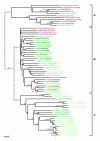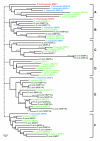The evolution of the vertebrate metzincins; insights from Ciona intestinalis and Danio rerio
- PMID: 17439641
- PMCID: PMC1867822
- DOI: 10.1186/1471-2148-7-63
The evolution of the vertebrate metzincins; insights from Ciona intestinalis and Danio rerio
Abstract
Background: The metzincins are a large gene superfamily of proteases characterized by the presence of a zinc protease domain, and include the ADAM, ADAMTS, BMP1/TLL, meprin and MMP genes. Metzincins are involved in the proteolysis of a wide variety of proteins, including those of the extracellular matrix. The metzincin gene superfamily comprises eighty proteins in the human genome and ninety-three in the mouse. When and how the level of complexity apparent in the vertebrate metzincin gene superfamily arose has not been determined in detail. Here we present a comprehensive analysis of vertebrate metzincins using genes from both Ciona intestinalis and Danio rerio to provide new insights into the complex evolution of this gene superfamily.
Results: We have identified 19 metzincin genes in the ciona genome and 83 in the zebrafish genome. Phylogenetic analyses reveal that the expansion of the metzincin gene superfamily in vertebrates has occurred predominantly by the simple duplication of pre-existing genes rather than by the appearance and subsequent expansion of new metzincin subtypes (the only example of which is the meprin gene family). Despite the number of zebrafish metzincin genes being relatively similar to that of tetrapods (e.g. man and mouse), the pattern of gene retention and loss within these lineages is markedly different. In addition, we have studied the evolution of the related TIMP gene family and identify a single ciona and four zebrafish TIMP genes.
Conclusion: The complexity seen in the vertebrate metzincin gene families was mainly acquired during vertebrate evolution. The metzincin gene repertoire in protostomes and invertebrate deuterostomes has remained relatively stable. The expanded metzincin gene repertoire of extant tetrapods, such as man, has resulted largely from duplication events associated with early vertebrate evolution, prior to the sarcopterygian-actinopterygian split. The teleost repertoire of metzincin genes in part parallels that of tetrapods but has been significantly modified, perhaps as a consequence of a teleost-specific duplication event.
Figures




Similar articles
-
The evolutionary conservation of the A Disintegrin-like and Metalloproteinase domain with Thrombospondin-1 motif metzincins across vertebrate species and their expression in teleost zebrafish.BMC Evol Biol. 2015 Feb 15;15:22. doi: 10.1186/s12862-015-0281-9. BMC Evol Biol. 2015. PMID: 25879701 Free PMC article.
-
The characterisation of six ADAMTS proteases in the basal chordate Ciona intestinalis provides new insights into the vertebrate ADAMTS family.Int J Biochem Cell Biol. 2005 Sep;37(9):1838-45. doi: 10.1016/j.biocel.2005.03.009. Int J Biochem Cell Biol. 2005. PMID: 15899586
-
Differential regulation of metzincins in experimental chronic renal allograft rejection: potential markers and novel therapeutic targets.Kidney Int. 2006 Jan;69(2):358-68. doi: 10.1038/sj.ki.5000049. Kidney Int. 2006. PMID: 16408127
-
The Ciona intestinalis genome: when the constraints are off.Bioessays. 2003 Jun;25(6):529-32. doi: 10.1002/bies.10302. Bioessays. 2003. PMID: 12766941 Review.
-
The Role of the Metzincin Superfamily in Prostate Cancer Progression: A Systematic-Like Review.Int J Mol Sci. 2021 Mar 30;22(7):3608. doi: 10.3390/ijms22073608. Int J Mol Sci. 2021. PMID: 33808504 Free PMC article.
Cited by
-
Experimental Dissection of Metalloproteinase Inhibition-Mediated and Toxic Effects of Phenanthroline on Zebrafish Development.Int J Mol Sci. 2016 Sep 8;17(9):1503. doi: 10.3390/ijms17091503. Int J Mol Sci. 2016. PMID: 27618022 Free PMC article.
-
Update of human and mouse matrix metalloproteinase families.Hum Genomics. 2010 Feb;4(3):194-201. doi: 10.1186/1479-7364-4-3-194. Hum Genomics. 2010. PMID: 20368140 Free PMC article.
-
Sexual selection and the molecular evolution of ADAM proteins.J Mol Evol. 2010 Sep;71(3):231-40. doi: 10.1007/s00239-010-9382-7. Epub 2010 Aug 22. J Mol Evol. 2010. PMID: 20730583
-
Unravelling paralogous gene expression dynamics during three-spined stickleback embryogenesis.Sci Rep. 2019 Mar 6;9(1):3752. doi: 10.1038/s41598-019-40127-2. Sci Rep. 2019. PMID: 30842559 Free PMC article.
-
Back to basics--how the evolution of the extracellular matrix underpinned vertebrate evolution.Int J Exp Pathol. 2009 Apr;90(2):95-100. doi: 10.1111/j.1365-2613.2008.00637.x. Int J Exp Pathol. 2009. PMID: 19335547 Free PMC article. Review.
References
-
- Bode W., Gomis-Ruth, F-X., Stockler, W. Astacins, serralysins, snake venom and matrix metalloproteinases exhibit identical zinc-binding environments (HEXXHXXGXXH and Met-turn) and topologies and should be grouped into a common family, the metzincins. FEBS Letters. 1993;331:134–140. doi: 10.1016/0014-5793(93)80312-I. - DOI - PubMed
-
- Black RA., Rauch, C.T., Kozlosky, C.J., Peschon, J.J., Slack, J.L., Wolfson, M.F., Castner, B.J., Stocking, K.L., Reddy, P., Srinivasan, S., Nelson, N., Boiani, N., Schooley, K.A., Gerhart, M., Davis, R., Fitzner, J.N., Johnson, R.S., Paxton, R.J., March, C.J., Cerretti, D.P. A metalloprotease disintegrin that releases tumour-necrosis factor-alpha from cells. Nature. 1997;385:729–733. doi: 10.1038/385729a0. - DOI - PubMed
Publication types
MeSH terms
Substances
LinkOut - more resources
Full Text Sources
Other Literature Sources
Molecular Biology Databases
Research Materials
Miscellaneous

